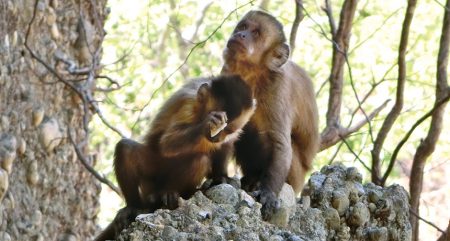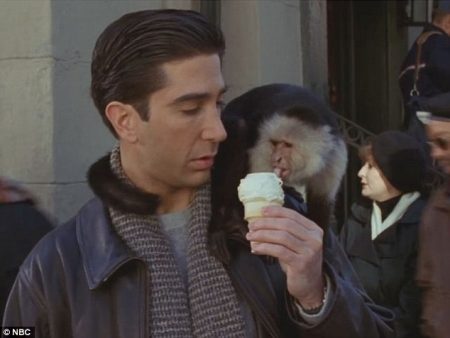October 20, 2016 – In the movie 2001: A Space Odyssey, an ape is seen playing with bones and reaching an “Aha” moment turning a femur into a club. The mythology of tool discovery in human ancestry is enshrined in that cinematic moment. But there is a new uncovered truth about tool making. It’s not such a big deal.
When my wife and I visited Costa Rica earlier this year we had our first encounter with capuchin monkeys. Our guides told stories about them, how aggressive they were, how they hunted in groups often attacking the gentler howler monkey troops, stealing their young. It painted a different portrait than the capuchin monkey, Marcel, a pet for Ross in the sitcom Friends, or the chain-smoking monkey, Ricky, featured in episodes of The Big Bang Theory.
I got a far different picture of capuchins upon reading the novel, The Jungle South of the Mountain, Andrew Westoll‘s story about an anthropologist obsessed with following and protecting a family of these monkeys in a South American country in political turmoil. In this fictional work the monkeys live in a rich and unspoiled tropical rainforest living a perfect vegan lifestyle. They just do what monkeys do. But wouldn’t Westoll have found the latest research on monkey business a wonderful addition to his story line?
What is that research?
Wild bearded capuchin monkeys in Brazil have demonstrated the ability to use stones to whack them against other stones creating sharp-edged flakes that resemble the stone tools of our hominid ancestors produced millions of years ago. In a paper entitled “Wild monkeys flake stone tools,” appearing in Nature and published online on October 19th, archeologist Tomos Proffitt, University of Oxford, notes that this is the first recorded observation of a non-human primate fracturing rock. In a video capuchin monkeys are seen pounding and even recycling flaked stones which they create.
Primatologist and archeologist Susana Carvalho, at University of Oxford, who did not participate in the study, describes what has been observed stating, “Without the intention of making a stone tool, and with the right rock types, capuchins produce objects that are shaped like stone tools,” suggesting that nonhuman primates have the capacity to develop something we thought previously unique to humans and our hominid ancestors.
Watch the video and note that the monkey pounding the rock stops from time to time to lick the area where it is working. The behaviour suggests it may be using the stone tool it has created to harvest powdered residue from the rock for its mineral or organic nutritional value.
Researchers studied 60 stone fragments produced by the capuchins they followed and found two excavation sites where monkeys practiced rock pounding activities. The stone flakes produced were smaller than those produced by hominid ancestors 3.3 million years ago in East Africa. But they also showed remarkable similarities to those modified stones.
Another surprising consequence of these observations is the bringing into question of other stone tool caches found by anthropologists and archeologists in Brazil, some dating back 14,000 years. Were these made by humans who crossed the Asian land bridge at the end of the last Ice Age, or, in fact, were they monkey business?
So it appears that the new way to distinguish ourselves from monkeys now must be shifted to another plane. It is in degrees of sophistication that we must measure what separates humanity from the monkeys. In other words what we have done versus capuchins is take what we learned from making early stone flakes and eventually building upon that to produce more sophisticated stone tools and then a technology-based, unnatural world that sets us apart.
I wonder what the monkeys would say to that?












